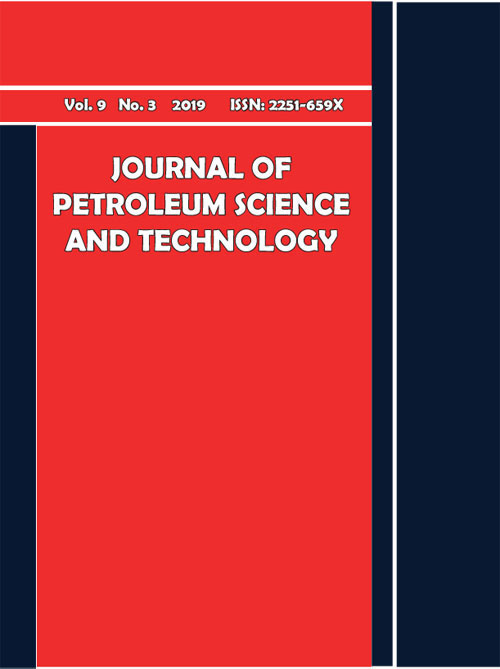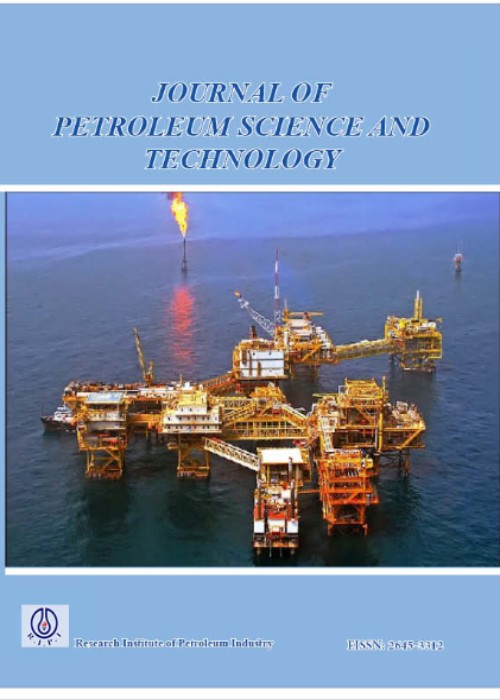فهرست مطالب

Journal of Petroleum Science and Technology
Volume:10 Issue: 2, Spring 2020
- تاریخ انتشار: 1399/03/20
- تعداد عناوین: 7
-
-
Pages 2-11Series of Mo-Co type catalysts were supported on Al2O3, Al2O3-meso-ZSM-5-Al2O3-typical-ZSM-5 and tested in the hydrodesulfurization (HDS) of straight-run diesel feedstocks. The materials were characterized by N2 physisorption, X-ray diffraction, scanning electron microscopy, NH3 adsorption and temperature-programmed desorption, and Py-adsorbed IR spectra. The dynamics of the main steps in the HDS reaction were calculated, and seven lumped kinetic equations were established containing reaction pathways of hydrogenation (HYD), direct desulfurization (DDS) and alkyl transfer on the catalyst. The Levenberg-Marquardt (LM) algorithm method was used then to solve the resulting differential equations. The results showed that the HDS activity of C12-ZSM5 was highest because it had large VP and DP, and moderate acid content, which could improve the alkyl transfer activity and the macromolecular sulfide diffusion. By increasing the operating temperatures, the sulfur removal through the alkyl transfer route on C12-ZSM5 catalyst significantly increased, and the removal of sulfur content through alkyl transfer at 400 °C and 4.0 MPa or 6.0 MPa was 86 or 88%, respectively. Furthermore, the increase of sulfur removal confirmed that the alkyl transfer route was dominant at a deep HDS level at a high operating temperature.Keywords: Mo-Co Type Catalyst, ZSM Zeolite, Hydrodesulfurization, Kinetics
-
Pages 12-17In conventional sour water stripping (SWS) in petroleum refineries, H2S and NH3 of the sour water are separated simultaneously at the top of a tray column by sending sour gases to the sulfur recovery unit (SRU). At SRU furnaces, ammonia is oxidized to NOx playing the role of a deactivator for downstream catalytic beds. From an industrial engineering viewpoint, it is proposed to strip ammonia and hydrogen sulfide separately using two stripper columns. The striped ammonia may be incinerated if it is allowed or traded as gaseous or aqueous ammonia. In this study, the two-column sour water stripping approach is implemented for the feed stream of an SWS unit currently working in Iran using a simulation model that was verified based on the design data of an industrial unit. It is concluded that the higher the pressure of the H2S stripper is, the higher the H2S recovery is, and the lower H2S impurity with ammonia stream is. Moreover, preheating of the feed stream and sending a lower portion of cold feed stream as a representative of liquid reflux resulted in increased utility consumption and also changed the amount of water sent with sour gas and ammonia stream. Finally, aqueous ammonia (less than 10% purity) or ammonia vapor stream (about 90% purity) can be traded as a value-added product for this unit.Keywords: Sour Water Stripping, Sour Gas, Ammonia, Stripped Water, Process Simulation
-
Pages 19-25The Parigi Formation has been a significant gas exploration in West Java Basin. This is due to their abundance, and they occur at shallow depths (800-1000 m). The main objective of this study was to focus on the characteristics and distribution patterns of the shallow carbonate to be used for gas storage. The case will be focused on Parigi Formation as a reservoir carbonate in the depleted oil and gas field in West Java Basin. These build-ups are better developed in onshore West Java Basin, where they exhibit coral reef frameworks and reach over 450 m in thickness. Moreover, Parigi Formation carbonate is well exposed in Palimanan, West of Cirebon City, and it is divided into four types of lithofacies. Preservation conditions, storage capacity, effective injection, and production are important factors in underground gas storage. In the geological site, factors that need to be evaluated are as follows: a reservoir, trap sealing, and tectonic activities in the surrounding area. However, in the USA and Europe, the porous reservoir formations such as sandstone or carbonate at depths of 500 - 1800 meters are common in storing natural gas in large volumes size. Ultimately, according to this case study, it has been found out that the most influential parameters for storing natural gas are porosity and permeability (petrophysical properties).Keywords: Gas Storage, Carbonate, Reservoir, Porosity, Permeability
-
Pages 27-34Catalytic naphtha reforming is practiced extensively in petroleum refineries and petrochemical industries to convert low-octane naphtha into high-octane gasoline. Moreover, this process is an important source of hydrogen and aromatics obtained as side products. Bifunctional Pt-catalysts used in reforming are deactivated by coking during its industrial operation. This results in a reduction of the yield and octane number. In this paper, modeling and optimization of a semi regenerative catalytic reforming of naphtha have been carried out by considering catalyst deactivation and complex multicomponent composition of a hydrocarbon mixture. Furthermore, a detailed coke formation mechanism was described. In addition, operating parameters (yield, octane number, and activity) for different catalysts were predicted and optimized. In addition, the analysis was extended to study the reactor configuration features and their influence on the process parameters. Finally, economic values were calculated, and the benefits of process improvement were demonstrated.Keywords: Catalytic Naphtha Reforming, Mathematical Modeling, Semiregenerative Process, Activity, Coke Formation, Product Yield
-
Pages 36-47Different sets of experiments were designed and conducted in a pilot plant to determine the effect of different operating conditions on the process efficiency and deactivation of the catalyst in the naphtha catalytic reforming process. Based on the experimental results, a kinetic model was developed and adapted for the purposes of prediction. The developed model represents the impacts of all input variables – including operating conditions, physical properties of feedstock, and chloride injection – on research octane number (RON), the yields of reformate l, and outlet reactor temperatures. Finally, by applying the model and an optimization algorithm, a pseudo-dynamic optimization of the process was carried out to minimize energy usage and improve the process efficiency by determining an optimum operating plan that also maximizes the yields of the average octane number and the liquid product. Also, by minimizing the increasing rate of weight average bed temperature of the reactors, the average energy consumption throughout a definite period was minimized. Finally, it is also estimated that by applying this method, the average conversion and average RON could be improved by 6% and 2.5 units respectively.Keywords: Gasoline Production Process, Deactivation of the Catalyst, Chloride Injection, Kinetic Model, Pseudo-Dynamic Optimization
-
Pages 49-55Over the years, unconventional reservoirs have not received attention in Iran in light of easy oil. The most significant oil reservoir in Iran is Asmari formation of Ahwaz oilfield which has been producing oil by natural flow potential. Due to the gradual pressure drop of Asmari formation and oil price increment, production from the base shale of this formation has been considered. However, due to the low permeability of this layer, oil production has not been achieved, and it has still remained a challenge. Production of petroleum from tight/shale rocks has become possible by hydraulic fracturing. This study has hired Asmari formation base shale as case study for hydraulic fracturing simulations. This paper is focused on a scientific process to construct a lithology-dependent one-dimensional geomechanical model in an oil well which is completed in Asmari formation. Moreover poro-elastic formulation has been used for in-situ stress determination. In addition, the tectonic stress regime has been identified as normal faulting. Afterwards, a hydraulic fracturing operation has been designed by the FracCADE simulator. During hydraulic fracturing operations, an uncontrolled-height fracture may occur due to the absence of stress-barriers in bounding layers. A hydraulic fracture was designed for a sublayer of the Asmari base shale based on the constructed profile of in-situ stresses to constrain the vertical growth. Ultimately according to the results of the simulation, it was illustrated that the designed fractures did not cross the bedding interfaces of Asmari base shale.Keywords: Fracture migration, Unconventional reservoirs, in-situ stresses, Geomechanical model
-
Investigation of Membrane Filterability in Membrane Bioreactors for Treating Oil Refinery WastewaterPages 57-63The evaluation of critical flux and pollutant removal in a lab-scale submerged membrane bioreactor (MBR) was performed for the wastewater of a domestic oil refinery. The flux step method and its behavior vs. transmembrane pressure (TMP) were studied to determine the critical flux of the membrane and the effect of TiO2 nanoparticles (NP) incorporation into polyvinylidene fluoride (PVDF) matrix on the membrane filterability. The effectiveness of MBR for treating effluent stream of dissolved air floatation (DAF) unit of the Tehran oil refinery wastewater plant was studied, and the results showed that TiO2 NP improved the efficiency of phenol removal. Ultimately, according to this study, 70 % enhancement in the critical flux of the PVDF/TiO2 membrane was obtained as a result of TiO2 NP tendency to reduce the fouling of PVDF membranes.Keywords: Membrane Bioreactor, Critical Flux, PVDF Membranes, TiO2 Nanoparticles, Oil Refinery Wastewater


